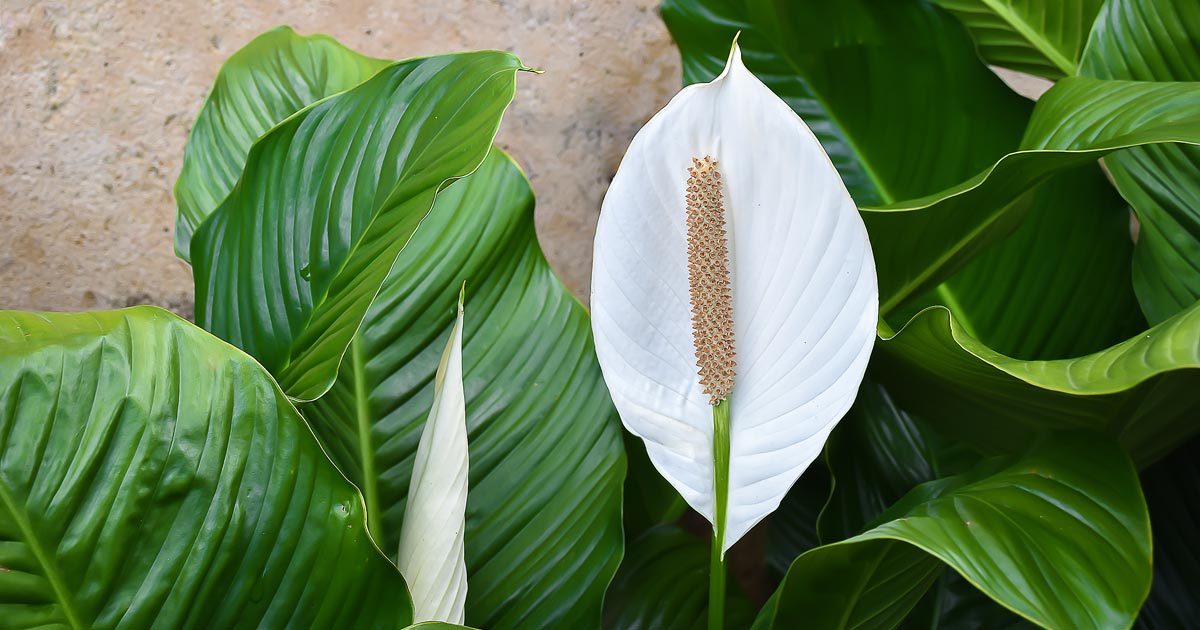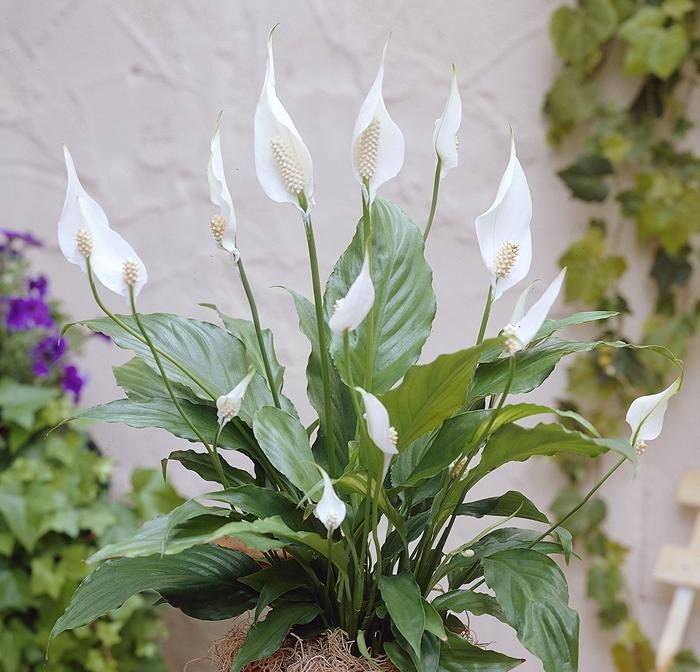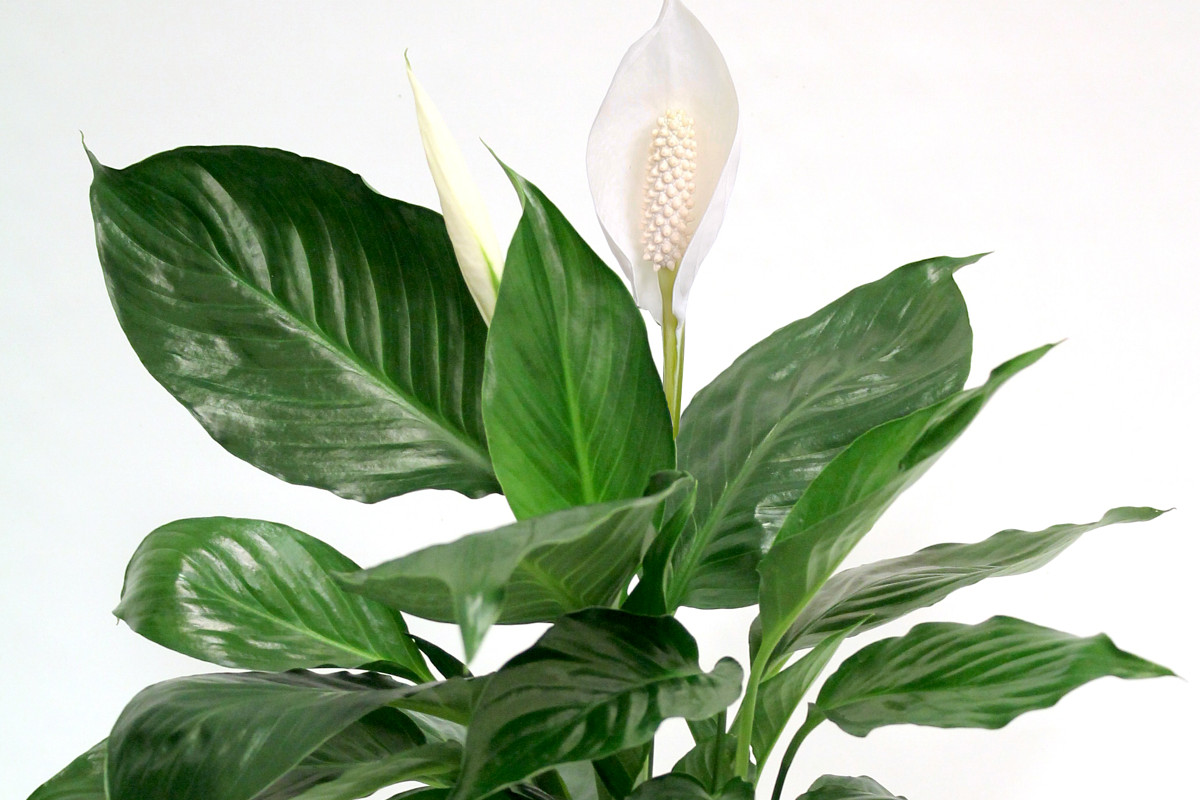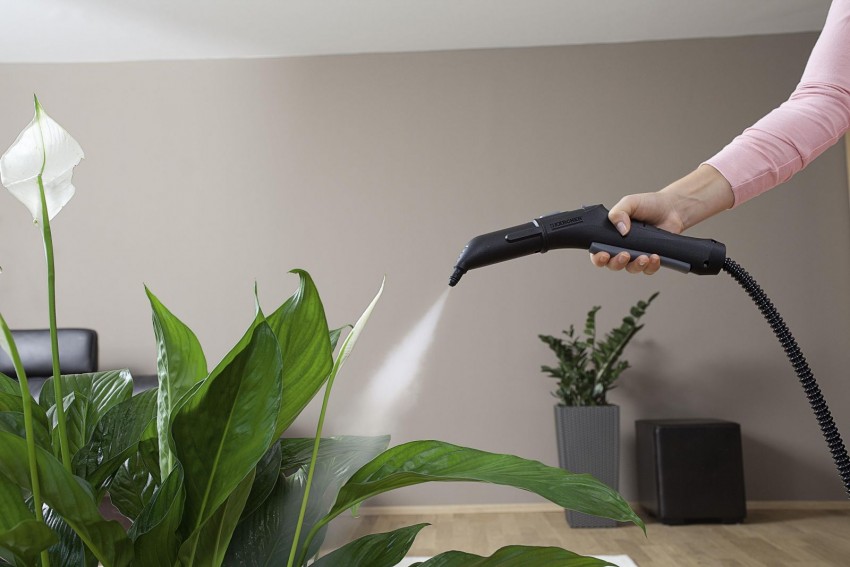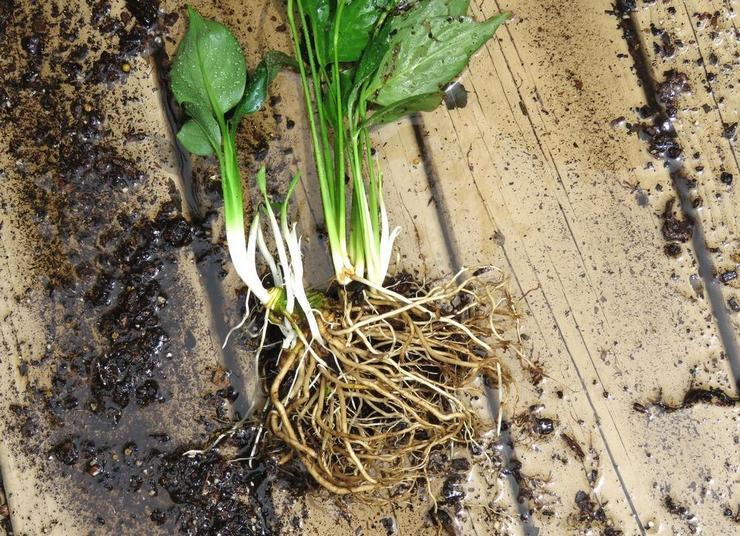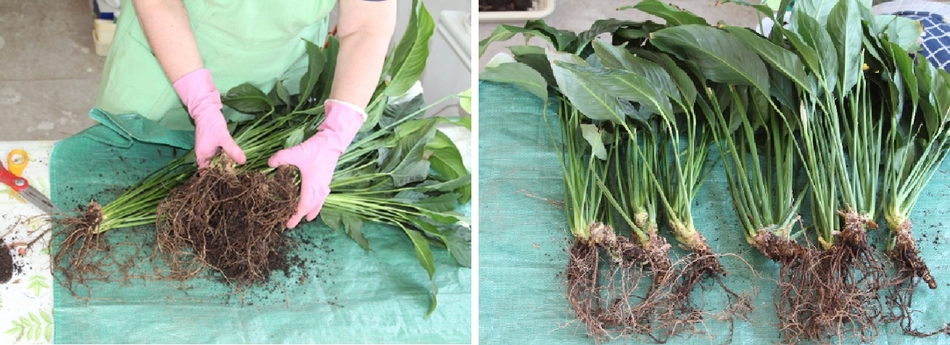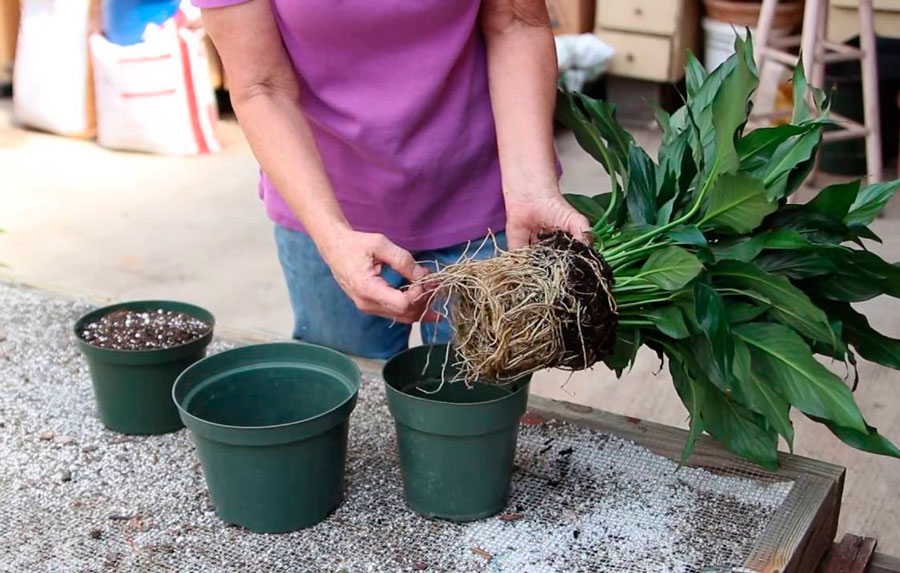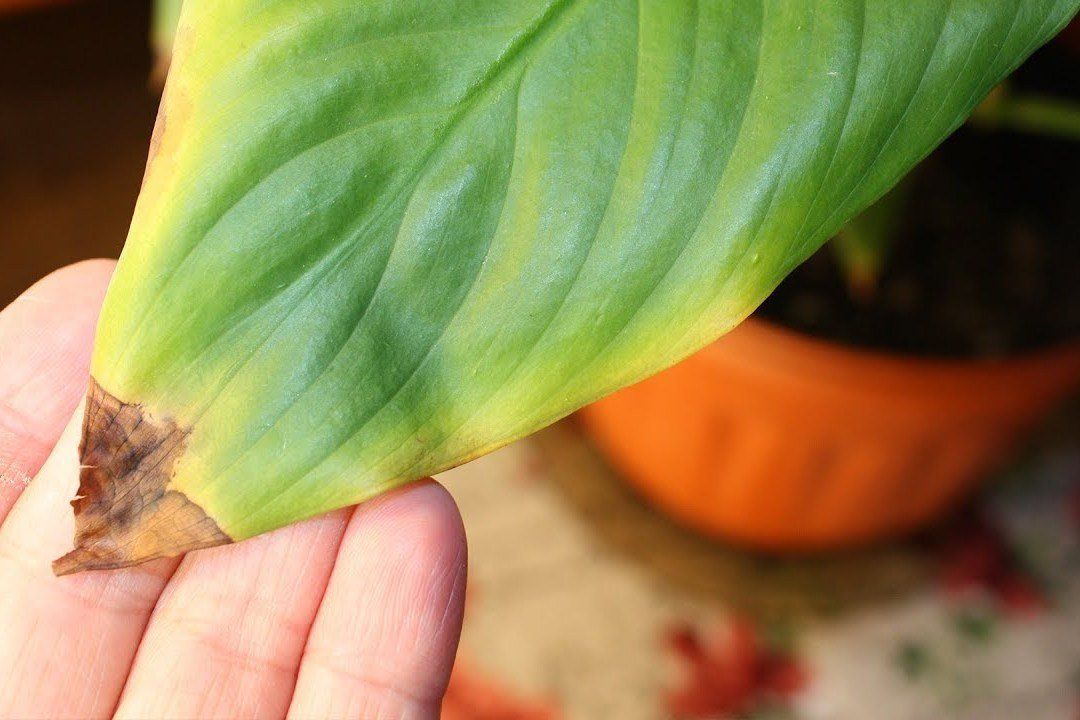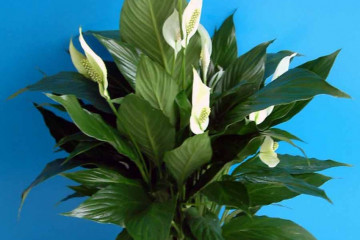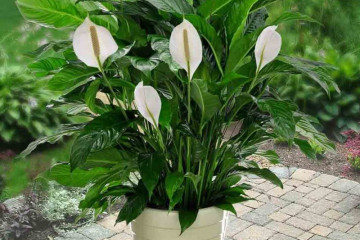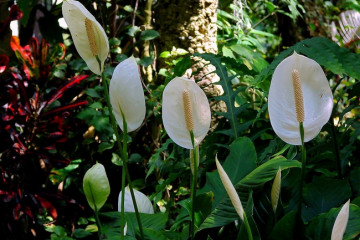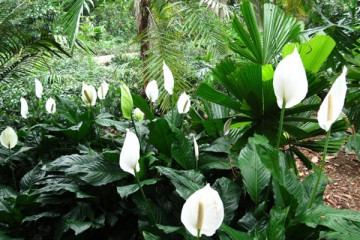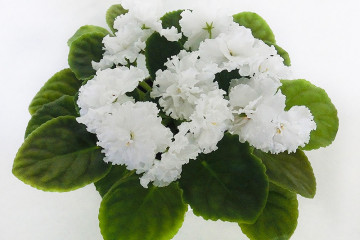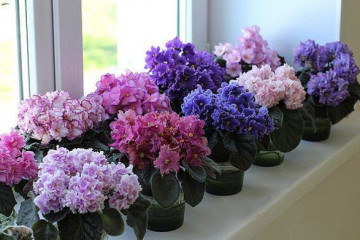Spathiphyllum chopin - description of a home flower
Content:
Spathiphyllum, originating from tropical forests, grows there in the lower layer of the undergrowth, in the shade of tall trees. Although it is impossible to create conditions in a home that resemble humid equatorial forests, the plant thrives and produces charming flowers that can decorate the interior of an elegantly furnished apartment.
Description
The plant has beautiful not only flowers, but also leaves: dark green, shiny, with sharp tips and long petioles, collected in dense rosettes. On their lower surface veins appear noticeably. The edges are smooth or slightly wavy.
In the description of Chopin's spathiphyllum, a characteristic feature is the complete absence of a stem, the leaves grow directly from the underground rhizome (perennial stem), usually elongated and functioning as an organ of reserve accumulation. In appearance, it resembles a root, but has buds at the top and roots at the bottom. The height of the bush is 30-60 cm, width is 30-50 cm.
During flowering, original white flowers with a delicate aroma, shaped like wings, rise on the shoots rising above the foliage.
What is usually called a flower - a white wing, in fact, is not. This bract is a modified leaf that wraps around the buds to protect them and attract insects. The inflorescence itself is cob-shaped and consists of male and female flowers. The bract turns white when it reaches maturity, but becomes pale green over time.
Spathiphyllum Chopin usually blooms from spring to autumn, six months after transplanting until the first flowers appear. This period is considered active in the life of the plant, accordingly, intensive watering and feeding are provided for it.
Healing properties
In addition to its decorative value, Chopin's spathiphyllum has the ability to purify the air from toxic substances. It also absorbs mold spores and harmful electromagnetic radiation. Harmful substances are absorbed from the environment during photosynthesis.
An additional beneficial property is that spathiphyllum converts carbon dioxide into oxygen.
History of appearance in Russia
Spathiphyllum belongs to the Araceae family, native to tropical America. Europeans learned about it after the German scientist Gustav Wallis discovered and described the plant. Wallis did not return from the expedition, one of the species of the flower was later named after him - Spathiphyllum wallisii. In the 19th century, they began to cultivate this plant in Europe, then it penetrated into Russia.
New varieties of spathiphyllum began to be developed not so long ago - 50-60 years ago. Spathiphyllum Chopin appeared as a result of the work of breeders.
Other types and differences
Today there are many hybrid varieties with their own distinctive characteristics. Most similar species to spathiphyllum Chopin:
- Tango. The external differences between spathiphyllum Tango and Chopin are so small that they are often confused. The sizes of adult plants are almost identical, the shape of the leaves and flowers are also. A slight difference may be the more vertical arrangement of leaf cuttings in the Tango variety, while the leaves of another plant tend to form a rosette;
- Cupido (Cupido Opal). The variety, bred in Holland, has a characteristic cone-like shape of the outer white leaf near the inflorescence;
- Verdi. In width does not exceed 35 cm, in height reaches 70. Abundant flowering;
- Alpha. The growth of the leaves is very similar to the Chopin variety, blooming from January to December, that is, almost all year round.
The main distinguishing characteristics of Chopin's spathiphyllum, which ensure its high popularity, are unpretentious care, abundant flowering, accompanied by a light aroma, and resistance to pests.
Care features
Spathiphyllum Chopin belongs to undemanding plants, it is easy to grow. However, it is necessary to create comfortable living conditions for plant health and stable long-term flowering.
Temperature
Ideal temperatures are 18 ° C at night and 20-25 ° C during the day. If these conditions are met, flowering will be constant from spring to autumn. For a short period and providing the necessary moisture, the plant can withstand temperatures up to 30 ° C. On the contrary, it is more afraid of the cold and does not tolerate temperatures below 15 ° C.
Lighting
In its homeland, Spathiphyllum is accustomed to partial shade and feels good even in the poorly lit north window. However, the lack of light damages the plant - the leaves stretch out and turn pale. Direct sunlight is also dangerous - burns quickly appear. The best choice is diffused lighting.
Watering
Spathiphyllum needs high humidity. Basic watering conditions:
- a bright and warm place - an increased need for water;
- shaded and cool place - need to water less;
- optimal irrigation rhythm - whenever the topsoil feels dry.
Spraying
The plant needs daily spraying. The water should be soft, at room temperature. Flowers and buds are protected from moisture when spraying, for example, with plastic wrap.
Humidity
When caring for Chopin's spathiphyllum at home, it is necessary to ensure high humidity. It is not recommended to place the plant near heating devices. A good effect is given by installing containers with water next to it.
Priming
Since moisture should not stagnate, a drainage layer of pumice balls, gravel, and brick chips is laid on the bottom of the pot. The substrate should be fertile, loose, with a slightly acidic reaction. When self-preparing the soil, it is necessary to mix leaf and sod soil, sand, compost from leaves in equal proportions.
Top dressing
During the active flowering phase, usually from spring to late autumn, the plant requires feeding. Fertilize once every 2 weeks. To properly care for a plant, it is imperative to study the composition of fertilizers. For spathiphyllum Chopin, which gives abundant flowering, it is preferable to use fertilizers containing the greatest amount of potassium (K) and other important trace elements: phosphorus (P) and nitrogen (N). Significant for the plant, but in smaller amounts, iron (Fe), manganese (Mn), copper (Cu), zinc (Zn), boron (Bo), molybdenum (Mo).
Winter care
During the dormant period, the number of waterings is reduced, feeding stops.If the plant continues to bloom, you can fertilize it once a month. The temperature must be maintained at least 16-18 ° C.
Pruning
Pruning is not required for a herb, but there are situations when you still need to take scissors:
- the leaves are completely or partially dried up, turning brown;
- root rot is removed to healthy roots;
- cut flowers if necessary, cut them as low as possible.
Reproduction
Spathiphyllum can be propagated by three methods:
- dividing the root;
- cuttings;
- seeds.
Most often, flower growers succeed using the first two methods.
Germinating seeds
The difficulty lies in the fact that the seeds for germination must be fresh, they can only be obtained directly from the mother plant, artificially pollinating it during the flowering period. Even if it was possible to obtain suitable seeds, the problems are just beginning, since they have a very low germination capacity.
Steps for growing from seeds:
- Lay drainage at the bottom of the planting container;
- Fill up loose substrate;
- Sow the soil with seeds, sprinkling them only slightly on top;
- Create greenhouse conditions by covering the container with glass or cellophane film, which are removed daily to avoid the appearance of mold;
- When the sprouts that appear will slightly increase in size, and the leaves appear, they should be transplanted into separate vessels.
Rooting cuttings
Produced during a period of active growth, when rosettes of young leaves are formed near the base of an adult plant. These rosettes are called cuttings.
Sequencing:
- Carefully separate the cuttings;
- A peat-sand mixture is poured into a container and young shoots are planted there. Sometimes they don't have roots yet. In this case, you can put the cutting in water for a while so that it gives roots;
- Moisten the soil and cover the container with a transparent film. As with seed germination, daily ventilation is required.
Dividing the bush
The most reliable and popular breeding method. The secret of success lies in the fact that the separated parts of the plant already have formed roots and very quickly take root in a new place. Procedure:
- Take out the spathiphyllum from the pot and gently shake off the soil from the roots;
- With a disinfected and sharp knife, the rhizome is delicately divided into parts, each of which has at least 2-3 leaves and well-formed roots. The sections are treated with charcoal;
- Young plants are planted in well-moisturized soil. In the first few days, do not water, just spray;
- Store in a shaded place until young leaves appear. This means that the plant is well established and normal care can begin.
Transfer
The need for transplants arises immediately after the purchase of a plant and as it grows, when the root system fills the entire space. Sometimes spathiphyllum grows so quickly that annual transplants are required, but on average it is transplanted every 2-3 years. The time for the procedure is spring, before flowering.
Transplant stages:
- Remove the plant from the pot along with an earthen clod;
- Carefully straighten the roots, shaking off the ground. Remove rotten roots;
- Cut out dry and very young leaves, as well as flower stalks, if any, so that the transplanted plant does not spend too many resources to support flowering;
- Place the plant in a prepared pot with drainage covered by 2-3 cm and part of the soil on top of it, sprinkle with substrate so that 2 cm remains to the edge. Then lightly tamp the soil, fixing the spathiphyllum tightly.Do not cover the root collar with earth;
- Do not water for two days after transplanting, only spray the leaves.
Often, the transplant is done simultaneously with dividing the rhizome for reproduction.
Growing difficulties
Incorrect lighting, fertilization and watering regimes can cause alarming symptoms and a general weakening of the plant.
Lack of flowering
Sometimes spathiphyllum does not bloom at all or sheds leaves and buds. Possible reasons:
- lack of light;
- too large a pot;
- there is no rest period;
- lack of minerals in the soil.
Leaves turn pale
Leaves lose intense light due to lack of light.
The tips of the leaves dry
If the tips of the leaves turn black and dry in spathiphyllum, then the following care errors are likely:
- lack of fertilizers;
- too abundant and frequent watering;
- lack of moisture.
Brown spots on the leaves
This also includes the problem of why the lower leaves fall.
Possible reasons:
- sunburn;
- rotting due to stagnant water in the soil;
- excess fertilizer.
When overfeeding the plant, it should be transplanted into fresh substrate immediately.
Pests
Plants weakened by improper care can infect pests: spider mites, aphids. They get rid of them when treated with insecticides (Aktara, Aktellik, etc.).
Signs and legends
Various legends and beliefs are associated with spathiphyllum, sometimes they call it "female happiness". According to one of the legends, the goddess of love Astarte breathed into the flower some of the happiness that filled her on her wedding day. From now on, the plant will bring happiness to every woman who believes in its power. Lonely, it should help to find a chosen one and become a mother, married to restore good relations in the family.
Spathiphyllum Chopin is a non-capricious plant, the efforts made to grow it are minimal. For those who believe in its power, it will bring harmony and happiness, for everyone, without exception, it will create a festive atmosphere in a room ennobled with luxurious flowers.

